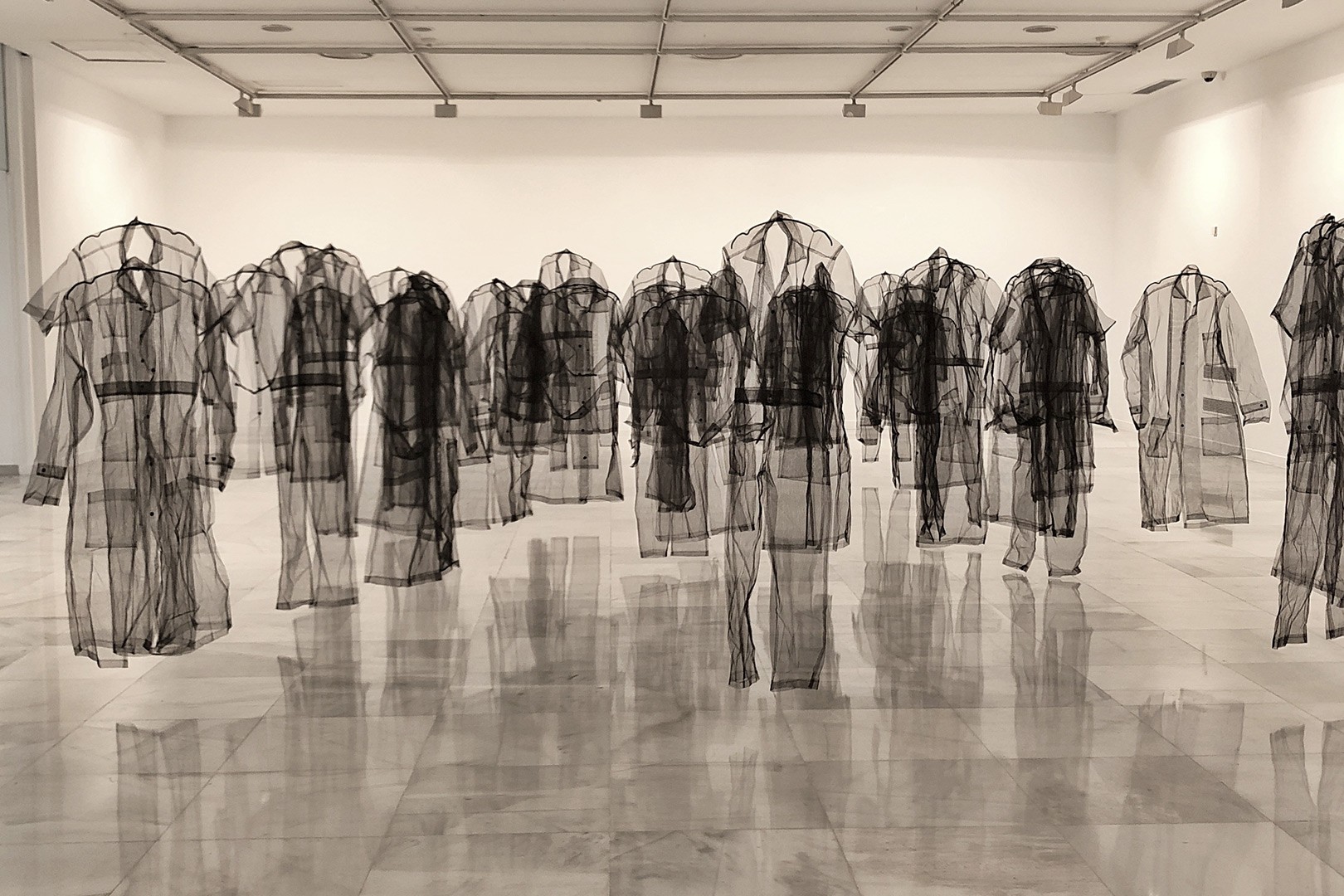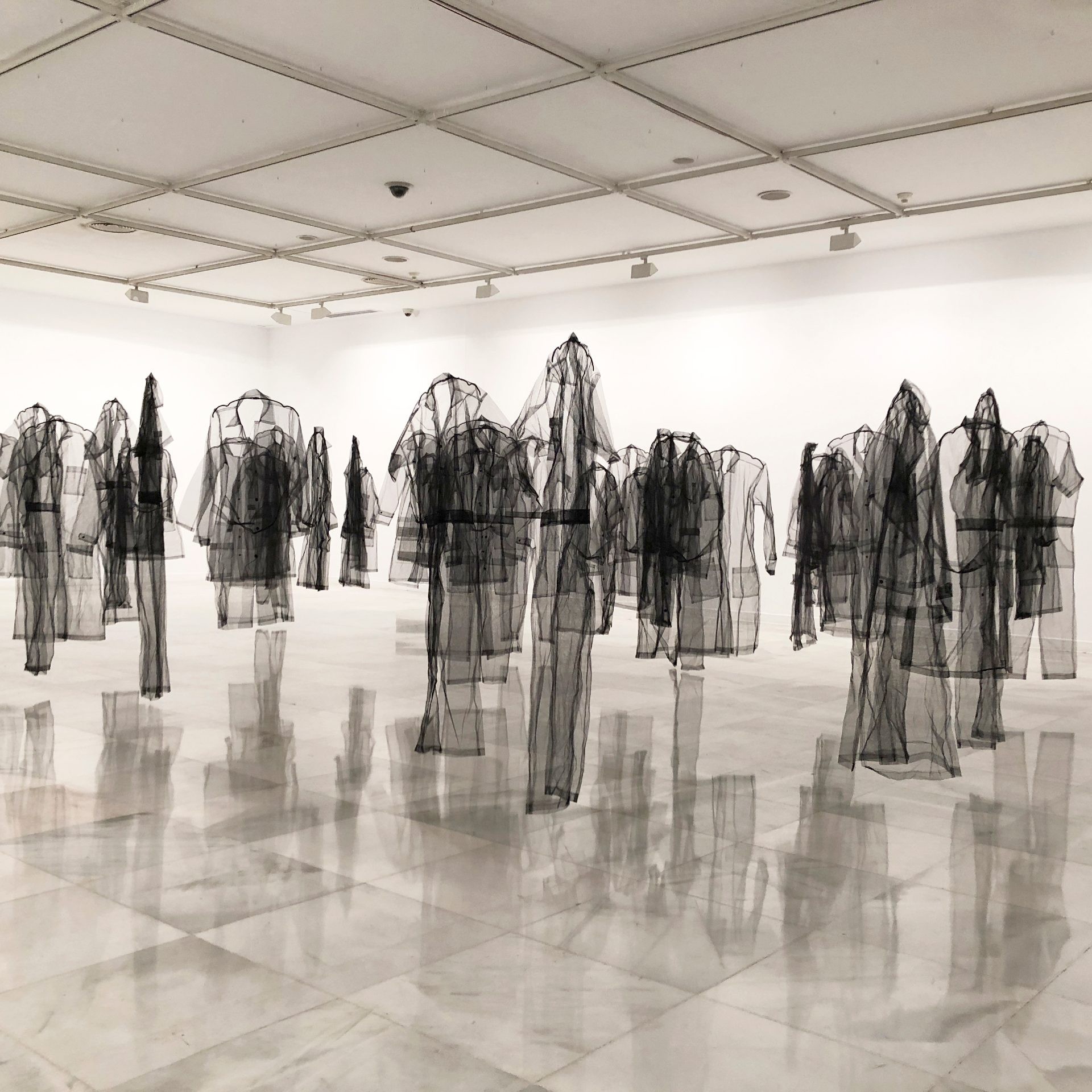Uniform
Black tulle uniformes
Variable dimensions
2009
Restitution of the dream
A garment defines sleep. A clothed sleep. The garment that defines sleep is vulnerable, volatile, intimate. It corresponds with a supposed domesticity and the hour in which the body rests to recover from whatever has happened. The restfulness of safe sleep.
A set of these garments is assembled by the artist as an installation. In different variants (be it filling a space with said garments or piling them up, as if they were a changing skin), these garments have been chosen by the artist for a cause only known to her. If she were to reveal the code, we would only have the voluptuousness of the body that abandoned the garment exhibited.
Casarino has been working with clothes for a while now. She always relates them to a gender perspective. She delivers, thus, a reflection. The garments only mobilize a turn of events, as if her works were a story. In that story, a narrative line develops in one direction, and another narrative line finds the first one; therein lies the turn of events.
We know that, in this installation, one of the narrative lines is completely visible: the garments. They speak to us of an intimate moment, a domestic life, behind closed doors. They also speak to us from the material with which they were tailored, tulle, as well as from their semantic ability regarding their interplay as veils (covering and revealing). Almost always associated, in our culture, to rites of passage, such as marriage or the fifteenth birthday of our young women, this material ―transformed into a stereotypical characteristic imposed in several cultural manifestations― is also providing us information. Its volatility and the game of transparencies proposed by tulle here does not only seem to approach that which is intimate, it is also an indication of that cliché: femininity as something volatile, as a subjectivity firmly adhered to social demands. That which is volatile: something easily dissipated. A transparent fabric that hangs from invisible threads, maybe hardly resistant, that affirms and reproduces a cliché about the feminine, its wrapping.
But, which is that narrative line that will not allow the first one to develop as it has been developing?
Therein lies the key revealed by the artist: traffic. A word with multiple meanings. One of them pertaining to people as objects of transaction.
Human trafficking, ever present in the histories of peripheral countries, supposes an economic movement surpassed only in its illegality by drug and arms trafficking. One of human trafficking's main goals is sexual exploitation. Generally, women, trafficked individuals are deceived by others (many times by people in their own social circles) offering them well paid jobs in some other country. Once at the airport they are stripped of their passports and taken to the real working site, from which leaving will be very difficult.
These garments, associated with sleep, with peaceful rest in that first narrative line, encounter an atrocious destiny. Some other narrative line preventing the first from developing as it was. Human trafficking barges into intimacy, making that which is vulnerable even more vulnerable: sleep is no longer safe and it may turn into a nightmare.
Perhaps, Claudia's dream is restoring that divested quietness, returning dreams to sleep. Returning, finally, the quietness of domestic sleep in the presence of a besieged intimacy and body, turned into trafficked merchandise.
Lia Colombino
The Thickness of Shadows
It is impossible not to relate this exhibition by Claudia Casarino with her previous one where transparent gowns were substituted by their own shadows (2005). In the current exhibition, the celebration of tulle has been substituted by the somber or severe obscurity of black, as if the moment of shadow—the image’s flipside—had managed to reclaim its rights and impose its subtracted presence. However, this appeal to black tulle does not only mark a counterpoint of opposing chromatic signs, but also the different rhythm for the same economy of the object: despite the expiration of its meanings, the white tulle of rites related to the radiance of female honor or virginity is abundant in the market, while the tulle that veils the widow’s face or faintly underlines the rigorous etiquette of certain funeral trappings is much harder to find. But this game between excess and dearth, or between the rite of celebration and that of loss—fundamental record in any approach about representation—barely grazes the availability of garment stock and centers on another tension, to then point to social and cultural meanings that surround the strict scene of that which is offered to the gaze or removed from it.
The white tulle gowns disturbed the light’s trajectory, making room for the dark figures they managed to project onto the wall. In the presentation I penned for said exhibition, I referred to Lèvinas brief sentence: “Art always leaves the prey for its shadow”. But this craving art has for illusion or the black back of things is nothing more than a deception of the gaze, to turn back on the thing—in the circumnavigation of its absence— and see it or know it suspended in a vacuum; surrounded, pierced, or inhabited by its own absence, which transforms it not into a real object, but into an image.
Although they are also manufactured with transparent tulle, these dark gowns manage to produce shadows by overlapping tens of identical pieces. Technically, this procedure does not project shadow (except for the projection of the seams that trace brief lines on the floor), but seems to re-absorb it, provoking a dense obscurity by condensation which, more than a somber stain, is a nocturnal mass, compact blackness turned on itself.
Following the inverse path, this demonstration/subtraction tactic coincides with the first (that of the white tulles) in the dissolution of the image—that may only be traced by the trembling contours of its own reflection—as well as in the dense thickness produced by overlapping light gowns. In both cases, the body is whisked away: the faint mass of overlapping veils and the dark signal projected by the uniforms veil/reveal the absence of their recipients. They appear by means of the metonymic force of the garments that summon their omitted figures; they present themselves as specters in a theater of shadows and veils. And that phantasmagoric status opens ascene beyond the scene.
And, from this place, another difference should be underlined: the white gowns corresponded to ritual or gala outfits, and their reiteration marked a paradigm of attire, a social model (in the fashion sense); while the black gowns allude to uniforms employed in certain types of “minor trades”, such as those worn by men and women working in teaching, nursing, mechanical shops, etc., so that their multiplicationindicates the standard of a hierarchically subordinate category. This distinction (in Bordieu’s sense) allows to glimpse through the figures of uniformed and anonymous people, semi-invisible, identifiable only by their uncertain silhouettes, only suggested by the vacant spots they have left while migrating to seek for illegal work (by the shadows that follow them in their hopeful or frightful odyssey, by potential widowhood announced in exile).
Perhaps, in this case, the gesture of composing a tight and somber figure may constitute a defensive strategy or a means of resistance; a way to weave the whole, thus restoring a certain possible image of the exiled social body.
Ticio Escobar




